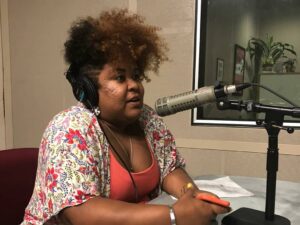Despite comprising more than 55 percent of the Brazilian population, Black people are still a minority in the country's major newsrooms, mainly in leadership positions. The lack of diversity in media is reflected in news coverage, which ends up reinforcing stereotypes and prejudices. To counteract this scenario, many Black media outlets and collectives have emerged in recent years in the country, to give visibility to the anti-racist struggle and to do journalism with a racial perspective. Many of them have projects to train students on how to do anti-racist journalism, in addition to training and mentoring Black professionals.
In November, Black Awareness Month in Brazil, LatAm Journalism Review (LJR) spoke to four of these media outlets, which you can learn about below.
Alma Preta
The journalism agency Alma Preta launched in 2015 and mainly covers national politics and the daily life of the peripheries, with a racial perspective. "The social security and labor reforms, for example, which were much debated, we covered these issues, interviewing experts and showing how it impacts the Black community in a more sensitive way. This is something that journalism does not do," Pedro Borges, co-founder and editor-in-chief of Alma Preta, told LJR.

Pedro Borges, cofundador e editor-chefe da Alma Preta
That is why Black media is so necessary, he said. "But the right thing would be for every journalist to do this, because it has to show how there are regions of the country, genders and racial groups that are going to be more impacted,” he explained. The outlet currently has 12 collaborators – most are located in São Paulo, but there are correspondents in Belém and Recife.
Borges said he created Alma Preta because he saw a "total lack of Black representation in the media," which generates "little objective coverage.” "We learned at the university that journalism is objective, it has thorough investigation, it has to show the contradictions of society. And there is no way to do journalism and be objective in Brazil if, when covering a large national story, the journalist does not explain the complexities of race, gender and territory. We lacked a journalistic objectivity that took into account structural pillars of Brazilian society,” he said.
For him, Black media provides more complex and objective coverage, showing how racism is not restricted to episodes of discrimination, but is part of the constitution of Brazilian society. "This is a great gain [that Black media brings], because it helps in the formation of people. Unlike the journalism of the corporate press, which generates passivity, our journalism almost calls people to mobilize.”
In addition, Borges said that these outlets employ Black professionals in a difficult labor market, marked by low wages, insecurity and mass layoffs. The agency publishes news on its website, social networks and a YouTube channel, and produces a podcast, Papo Preto, and a free newsletter.
Alma Preta also develops a writing manual with students from three universities to guide the work of the outlet and other Black media. The agency supports itself through crowdfunding campaigns and advertisements on the website. Subscribers who make a monthly contribution also have access to exclusive content.
Correio Nagô
Correio Nagô was launched in 2008 by university students who fought for the democratization of communication and had the anti-racist struggle in common. The group was concentrated in Salvador, which has the largest percentage of residents of African ancestry outside the continent, where they founded Correio Nagô.
Journalist André Santana, founder and editor of the outlet, told LJR that the group started its activities with media monitoring, training of young people for critical reading and educommunication. "Then we realized that it was not enough just to criticize the media, we needed our own outlet,” he said.

O jornalista André Santana, fundador e editor do Correio Nagô. Foto: Arquivo pessoal
The media outlet, focused on racial issues, is made up of three people and works with collaborators. The content is published on a website, social networks and a YouTube channel, Tv Correio Nagô. Correio Nagô is part of Instituto Mídia Étnica, an Afro-Brazilian media organization, which receives contributions through international projects, grants and foundations.
In addition to the site, Correio Nagô has a project, in its third edition, to train journalism students on how to cover race relations. The last course had 25 students and lasted four months, with weekly face-to-face meetings. The third edition has been postponed due to the pandemic and should resume as soon as possible.
The outlet’s name comes from one of the forms of resistance of the first enslaved Black people, who transmitted knowledge and information through oral history, according to the site's explanation. "Correio Nagô is word of mouth communication among Black people, between the enslaved Black community. Because in the rebellions, in the quilombos' fighting, this conversation between each other was very important in our history here in Brazil, because obviously we didn't have media outlets,” Santana said.
He said the expression is still used in Salvador. "We heard this a lot: 'it didn't come out in any newspaper, I heard it through the Correio Nagô,’ through word of mouth. And we thought about it when we chose the name. We wanted people to know, through the Correio Nagô site, what they didn't learn from other outlets," he said.
Launching their own outlet, Santana said, was an attempt to counter the traditional press, which reproduced many stigmas about the Black population. "We saw little Black presence in journalism and when we saw it it was a very negative approach. There is still this, especially in stories about security, violence. It is always an approach of criminalization, linked to misery. The outlets [of Black media] work to show the diversity that exists in Black communities. Yes, there are many problems, but it also has a lot of potential, a lot of good things," he said.
For this reason, Santana explained that Correio Nagô likes to publish positive articles on Black religion, art, culture, education and entrepreneurship. "We also talk about Black innovations, technology, economics, areas that are lacking in traditional media.”
However, the outlet also covers cases of racism and Black movement activities, such as acts and demonstrations. "We try to balance stories about denunciation of racism and religious intolerance with these positive stories. But if we could, we would cover [the positive ones] more."
Santana believes that Black media outlets tend to better contextualize problems. "There is no point talking about the war on drugs without mentioning that the security policy is racist, genocidal, that has death as its purpose," he explained. These outlets, he argues, also diversify sources, giving space to Black intellectuals, specialists, artists and leaders, who do not usually appear in the traditional press. "They are media that listen and present what these people think about the country's problems.”
Notícia Preta
Notícia Preta was founded in 2018 by journalist Thais Bernardes after she worked at several traditional newsrooms. According to her, the idea of launching an outlet arose out of "a desire for representation" and for identifying that it was very difficult to do journalism with a racial perspective within the traditional press.

A jornalista Thais Bernardes, fundadora e editora-chefe do Notícia Preta. Foto: Arquivo Pessoal
"Often, in the news I made and reproduced, I didn't have an anti-racist language. And when you don't, you end up stereotyping that Black body in the stories. I started to think that I had to do a different kind of journalism," Bernardes, founder and editor-in-chief of Notícia Preta, told LJR.
The outlet defines itself as an anti-racist media outlet and focuses on political and police beats – areas in which Bernardes had more experience. "Our strong point is hard news. I come from the factual, from covering the police [beat] a lot, which is where most of the time the Black body appears associated with violence, marginality and vulnerability. How do we portray this type of news not summarizing the Black person to that? It is a great challenge to cover police with an anti-racist approach and to do non-punitive journalism,” she said.
When working in the traditional press, she used to encounter white editors who, many times, resisted betting on what she calls "non-violent and racialized language."
"The [traditional] editor will want a headline: 'Drug dealer is arrested with 15kg of cocaine.’ But you cannot say that a person is a drug dealer if he has not even been tried. In Notícia Preta, this would not be news, because to what extent is [...] putting the Black person in the media always in the place of the violent drug dealer valid? But we could talk about 'suspected of' drug dealing, because when you are arrested you are accused of something, you are not that thing,” she emphasized.
For Bernardes, outlets like Notícia Preta not only provide access and visibility for Black journalists, but also exercise an educational function. "I see journalism as a process of education and formation of an anti-racist society. It is through education that we manage to change something,” she defended.
The educational role is not limited to the public. Notícia Preta also works as an incubator for young Black journalists, Bernardes said. "It is very difficult for Black students to pass selection processes, which ask for fluent English, and to enter the traditional press. So we do training, accompany the student, go to the street and do a report together,” she said.
The nucleus of Notícia Preta includes a designer and a programmer, in addition to Bernardes. The outlet operates with 17 collaborators in 11 states of the country. Bernardes said the goal is to produce national coverage and not just cover the Southeast region, where there is already the largest concentration of media in the country.
The journalist works on the project on a voluntary basis because Notícia Preta is not yet sustainable. "I took a lot out of my own pocket. Everyone has another job, nobody lives off of Notícia Preta," said Bernardes, the communication coordinator for the state government of Rio de Janeiro. Although not yet sustainable, the site has a small revenue with sponsored content, advertisements and support from readers, who can contribute R$ 9.90 (about US $1.84) per month.
Revista Afirmativa
The Black media collective Revista Afirmativa started to organize in 2013 and officially launched its site in 2014, together with the first print edition of the magazine. The outlet was developed by journalism students at the Federal University of Recôncavo in Bahia (UFRB), more specifically in the city of Cachoeira. To date, the majority of the team, composed of five permanent professionals and just over ten collaborators, is based in the interior of Bahia and in the capital, Salvador.

A jornalista Alane Reis, cofundadora e editora-chefe da Revista Afirmativa. Foto: Arquivo Pessoal
"The university journalism program is in Cachoeira, which is an emblematic city in relation to the history of the political organization of the Black population, it has brotherhoods that fought against slavery. It is a very rich place in the Black movement,” journalist Alane Reis, co-founder and editor-in-chief of Revista Afirmativa, told LJR.
The outlet covers the entire country, but prioritizes the Northeast and Amazon regions. "The corporate media does not usually give visibility to issues of human rights violations in these places," explained Reis, who is also a Black media researcher at UFRB.
The website's goal was to cover affirmative action policies that, at that time, were questioned in court. "There was a very reactionary debate around quotas in Brazil at that time," Reis recalled. Over time, the outlet started to include other themes.
"A beat we give preference to is the debate about the genocide of the Black population, public security, the extermination of Black youth, violence against women, feminicide. Another priority beat is the traditional peoples, especially the Quilombola and Indigenous populations, in addition to political participation of the Black population and the defense of democracy," Reis said.
The journalist claimed that the outlet produces content on the themes of social and political life in general, especially on racial tensions. "As the Black population is the largest part of the Brazilian population, we do journalism that has the perspective of the majority of the population as a central point. Our slogan is 'It is us, talking about us, for everyone.'"
In addition to the news from Revista Afirmativa being made by Black journalists, the outlet also favors Black sources. "Our criticism is that traditional journalism tends to turn to Black people to speak exclusively about racism. As if Black people have no training, expertise and intellectual production in other fields."

Parte da equipe e colaboradores da Revista Afirmativa. Foto: Divulgação
For Reis, Black media outlets contribute to recovering the ethics and social function of journalism. "Faced with an erosion of the hegemonic and traditional media, what we, Black media in general, do is to recover this legitimacy of journalism, this journalism centered on the public and collective good.”
She pointed out that, like other Black media, Revista Afirmativa faces financial difficulties. Currently, the media outlet has no fixed financing, subscription program or advertisements. To contribute, the reader can get in touch through the website. "Formulating a sustainable business model is today our biggest challenge,” she said.
On another front, between June and September 2020, Revista Afirmativa organized the Afirmativa Journalism Lab. The outlet selected nine young Black people, journalism students or recent graduates, to participate in theoretical and practical training in journalism and Black media. Participants went to the field to produce reports on the coronavirus pandemic in the peripheries and favelas. The content was published on the website and put together in an ebook.
This story was originally written in Portuguese and was translated by Teresa Mioli.